Boletus mushrooms are examples of edible. Tubular mushrooms. Description and habitat
Depending on the structure of the spore-bearing layer, fungi are divided into tubular (spongy), lamellar and marsupials.
tubular mushrooms
This group of mushrooms is called tubular, or spongy, because the lower part of their cap resembles a sponge, consisting of thin tubes. The most famous of them are white fungus, boletus, birch, butterdish, flywheel. White mushroom (boletus) is most often found in coniferous and birch forests. According to its nutritional and taste qualities, it is the most valuable of edible mushrooms. At the young white fungus the cap is convex, rounded, pale yellowish in color, later it becomes flatter and darker. A fully developed fungus has a reddish-brown or dark brown cap, depending on the tree species in which it grows. The underside of the cap young mushroom white, then becomes yellow with a greenish tint. The leg is thick, dense, often swollen at the base, has a thin light mesh in the upper part. The pulp is dense, when broken it retains a white color.
Has a lot in common with white gall fungus, which, although not poisonous, is inedible due to its sharp bitterness. A distinctive feature of the gall fungus is the reddening of its pulp when broken. Besides, top part the legs of the gall fungus are covered with a pattern in the form of a black mesh, while in the porcini fungus this mesh is light.
Boletus (aspen, red mushroom) grows mainly under aspens. It has a slightly velvety yellowish-red or brown-red cap. The leg is straight, high, white, with dark scales. At first, the diameter of the cap and root is almost the same, but with age, the diameter of the cap increases significantly. The flesh is dense, white, when broken, it first turns blue, then becomes purple-black. The boletus is best used in fresh(for frying and boiling and for pickling. It can also be dried and salted. Birch (boletus) grows in birch forests or in mixed forests, but in those where there is a lot of birch. The color of the hat is of various tones, from grayish yellow to dark brown. The lower surface of the cap is grayish with separate rusty spots.The leg is thinner than that of the boletus, dense, white with gray scales.The flesh is watery in wet weather, does not change color when broken.
Birch is used for boiling and frying, less often for drying. Young birch trees are good for pickling and salting.
Maslenok (maslynik) grows mainly under pine trees, among small spruce undergrowth, in conflagrations. The cap of the mushroom is yellowish or reddish-brown, mucus-oily, in wet weather it is especially abundantly covered with mucus. The lower surface of the cap of a young mushroom is light yellow, covered with a white film connecting the edges of the cap with the stem. With age, the film breaks, forming a ring around the leg. The leg is short, dense, yellowish. The flesh of the mushroom is light yellow, does not change color when broken.
Mokhovik grows in coniferous and mixed forests, especially well on the edges. The hat is velvety in various tones - from olive to chocolate brown. Bottom surface of the cap yellow color; the leg is dense, short. The pulp is light yellow, dense, slightly bluish when broken.
Mokhoviki are very good fried and pickled. Young mushrooms are also used for drying and salting.
agaric mushrooms
At agaric on the underside of the cap you can see thin plates diverging from the middle to the edges, like rays. This group includes the following edible mushrooms: mushrooms, milk mushrooms, volnushki, chanterelles, mushrooms, russula, champignons and others.
marsupial mushrooms
In marsupials, spores are formed inside special sacs. This group includes morels, stitches and truffles.
Or otherwise bilious. It is distinguished by a mesh on the leg and a bitter taste (it is enough to touch the tip of the tongue under the hat). And you just can't eat it, it's very bitter
Yours look like oilers, so rather they are. There are many types of them.
In the forest, indeed, it is better to walk with more experienced mushroom picker. And in pictures or even photographs, mushrooms are very often similar.
Test on mother-in-law - then throw away or eat
You just need to remember them and ... good luck with your "quiet hunt"
Mushroom encyclopedia - edible, inedible, poisonous mushrooms, recipes, photos of mushrooms - edible mushrooms
Most edible mushrooms, as well as poisonous ones, belong to tubular and agaric mushrooms. Tubular - these are all mushrooms in which the lower part of the cap has a tubular structure. Sometimes they are also called spongy, because the lower part of the cap resembles a sponge. In agaric mushrooms, the underside of the cap consists of thin plates. Both tubular and agaric fungi are included in a large group of so-called basidiomycetes.
Mushroom reproduction occurs vegetatively, for example, by budding, in other words, by dividing the fungal cell in two or dividing into sections of the mycelium located in the soil in the form of threads, as well as with the help of spores, which are the smallest fungal embryos.
In basidiomycetes, they develop on special protrusions - basidia. Basidia are located in a tight layer on the so-called hymenophores, located on the lower part of the mushroom cap. In tubular fungi, hymenophores look like tubules, in lamellar ones they look like plates. The basidia and spores are so small that they cannot be seen with the naked eye.
In addition to basidiomycetes, there are also marsupials. In marsupials, spores develop into special spores - bags. These bags cover the entire surface of the fruiting body of the fungus in a dense layer.
Edible Boletus Mushroom
- Gandhi
- room in the theater
- learned mason
- master of words
- main part of the temple
- 911 on wheels
- Shia colleague of the bishop
- Indian people
- gloominess gloominess
- kiln in the middle east
- reverse alias
- national hero of mexico
- natural polyhedron
- magician with a talking donkey
- Indian people (******)
- portion of material for the blast furnace
- detective element
- black with a gray tint
all popular queries →
All alphabetically
Mushroom guide
Which mushrooms can be harvested and which ones can be eaten.
There are no universal methods for determining the edibility of mushrooms. Silver spoons, onions and other items immersed in a saucepan with mushrooms behave completely regardless of the degree of poisonousness of the broth. The interest shown by animals and insects in certain types of mushrooms also does not mean anything. Even the experience of the natives of a particular village (“twenty years we collect such and are alive”) does not allow one hundred percent to avoid poisoning, since “folk” identification methods are often based on bright , but changeable signs.
It would seem that you can collect everything supposedly edible, and when you return home, conduct a thorough examination of the trophies with the help of the Internet or an expert living in the neighborhood. Unless circumstances intervene, such as:
the expert is drunk or not competent enough;
the computer fell into the pond;
the collected mushrooms lost the fragments necessary for determination during the collection and transportation;
the use of the collected is expected on the spot (in field conditions).
Yes, and to argue that it is easy to identify all types of mushrooms by the determinant of mushrooms, description or photograph, only a seasoned specialist who has already forgotten that “obvious” signs acquire this evidence only with experience.
The authors of mushroom determinants strongly recommend remembering everything that they remember, and then they are surprised how people, occasionally falling into the forest, confuse champignon or green russula with pale grebe, agalerin bordered with honey agaric. Far from everyone who went “for mushrooms”, these same mushrooms are one of the main hobbies in order to devote sufficient time for appropriate education. Despite the fact that an ordinary city dweller is not up to mycology, sometimes he still wants mushrooms. Or there was a problem of "survival", such as "a plane crashed into the taiga" - and the share in the diet is growing rapidly. Then in "Russian roulette" - every ninth russula - death cap. Or painfully remember what you saw a couple of years ago in the determinant of mushrooms, something from 300-600 species.
In fact, there are two known safe attitudes towards the collection and consumption of mushrooms. The first is to completely abandon the joys of “quiet hunting” and be content with cellar champignons, the second is to become an educated and experienced mushroom picker, which involves regular work with several reference books and mushroom guides, and the opportunity to visit “mushroom places” much more often once a year.
Fully supporting and sharing the beliefs of the fans of the second option, I would like to propose a third method as an alternative to the first. It is not necessary to refuse the selection and consumption of all mushrooms, it is enough to leave only those groups of edible mushrooms that have unambiguous signs that do not require different interpretations. And there should be no more than two signs of these per group, so they are not difficult to remember. The proposed description can be “verbally” conveyed to a person who has never seen mushrooms before, and he will not make a mistake when collecting. Of course, you will have to sacrifice many wonderful mushrooms, such as honeysuckle, russula and champignons, but it is instead of them that pale and not very toadstools fall into the basket of an inexperienced mushroom picker.
Three groups of safe mushrooms that do not cause identification problems and one rule that ensures safety (3 + 1):
1.Tubular mushrooms (with a tubular, sponge-like layer of undercap);
2. Milky mushrooms (agaric fungi that secrete opaque milky juice on a cut or on plates);
3. Raincoats (spherical or pear-shaped mushrooms with uniform white flesh).
1. All mushrooms 20 minutes, drain the broth.
Notes: The highlighted groups have inedible mushrooms, due to the bitter taste (for example, gall fungus), but they are not poisonous either. There are conditionally edible (some lactic mushrooms, satanic mushroom, duboviki), which are edible only after boiling. take risks and boil everything. For raincoats, “homogeneous pulp” is a very important feature - there should not be a structure of separation of the stem and cap inside. Most lactic mushrooms are used only for pickles (due to some bitterness), and these are the best mushrooms for this. Therefore, if even after boiling the mushroom is bitter, - in salting. Of course, you should not use wormy and old mushrooms, as a rule, their appearance does not favor this.
As an addition, I would like to note that, according to statistics, the culprit of 95% of serious mushroom poisoning is the pale grebe. According to the experience of communication with many "specialists" in mushrooms, most of them have a vague idea of the appearance of this unique carrier of the most powerful poison that is not destroyed by heat treatment. If all other conditions are preserved, it is enough to remember the characteristic signs of a pale grebe to reduce the likelihood of a sad end to a mushroom picking trip by twenty times.
To get acquainted with other types of mushrooms - a detailed photo atlas - a determinant of mushrooms ...
Poisonous and inedible tubular mushrooms.
Sometimes there is an opinion that all tubular mushrooms are edible.
However, this is an erroneous assertion. Among the tubular (bolet family) there are also inedible and even poisonous ones. In addition, some species of this family have been discovered recently and / or are very rare, so their edibility is uncertain (for example, rose gold boletus and false satanic mushroom - there is one). But you are unlikely to find these mushrooms - they are very rare.
There are many similar mushrooms in the genus Borovik. These are: deep-rooted boletus (Boletus radicans), beautiful boletus (boletus calopus), purple boletus (Boletus purpureus), Kele's oak tree (Boletus queletii). All of these species are inedible.
Now let's talk about poisonous tubular mushrooms. There are three species considered poisonous: Boletus le galliae (sometimes erroneously translated as lawful boletus), Satanic mushroom (Boletus satanas) and Beautiful boletus (Boletus pulcherrimus). These species are not fatal, but very unpleasant. They cause gastric upset (symptoms of poisoning - diarrhea, nausea, vomiting, abdominal pain), poisoning passes without a trace, no deaths have been recorded. I must say that the same effect can be when eating raw some edible mushrooms, including tannery.
Some believe that these mushrooms are edible if boiled, but this has not been proven, so I do not recommend experimenting.
Also, note that many of these mushrooms are colored in brightly red color. It is hardly possible to meet edible tubular mushrooms with hats and legs of this color in Russia (after all, we are not tropics :)). The exception is the speckled oak (it has a bright red hymenophore) - a good edible mushroom, no worse than white.
Boletus Mushroom
- Gandhi
- room in the theater
- learned mason
- the trumpeter inserts it into the socket of the pipe
- master of playing with words
- main part of the temple
- 911 on wheels
- Shia colleague of the bishop
- Indian people
- gloominess gloominess
- kiln in the middle east
- reverse alias
- national hero of mexico
- sailor military overshirt
- natural polyhedron
- magician with a talking donkey
- Indian people (******)
- portion of material for the blast furnace
- detective element
- black with a gray tint
all popular queries →
All words alphabetically
polish mushroom
Among the wide variety of tubular mushrooms, there are little-known ones, although they are tasty in all types of processing - boiled, fried, pickled, and even dried.
Kozlyak
Grows in moist pine forests, sphagnum bogs overgrown with pine, found in groups or singly from June to November. This mushroom is also called cow fungus, lattice.
Hat up to 12 cm in diameter, flat-convex, smooth, thinner along the edge, reddish-yellowish, ocher-pink, brownish. The flesh is whitish-yellow, slightly reddening, without special taste, weak, but pleasantly smells. The tubular layer does not separate from the cap, tubes with large uneven angular pores (like a sponge). Leg up to 10 cm long, 1-2 cm thick, of the same color with a hat or slightly lighter, cylindrical, often bent near the ground.
Mushroom edible, 4th category. Kozlyak outwardly similar to a pepper mushroom, but this twin is almost half the size of a goat, its flesh is caustic-bitter, and the tubular layer is yellowish-red.
polish mushroom
Distributed mainly in the southern part of the forest zone, found in Western Belarus, the Baltic states, Western Ukraine, grows in coniferous forests singly and in groups from June to November. This mushroom is also called brown, as well as pansky.
The cap is up to 12 cm in diameter, convex in a young mushroom, later flat, reddish-brown, chestnut, dry, velvety, slippery in wet weather. The tubular layer in young mushrooms is whitish, later yellowish, in old mushrooms it is greenish-yellow, turns blue when pressed (this polish mushroom different from white). Leg up to 8 cm long, cylindrical or slightly swollen, solid. The pulp is strong, white or whitish, turning blue in the air, without any special smell and taste.
Mushroom edible, 2nd category, in Western Europe counts best mushroom, it is fried, boiled, salted, dried. Name "Polish" mushroom received, apparently, because in the past the European market came mainly from Poland. It bears some resemblance to the inedible gall fungus. Their main differences: when pressing on the lower surface of the cap Polish mushroom a blue-green color appears; the tubular layer of the Polish fungus is greenish-yellow, and that of the bile fungus is grayish-pink; the taste of gall fungus is very bitter.
Dubovik ordinary
It occurs mainly in the south of the forest zone of the European part of the USSR and in the Caucasus, grows from June to September, most often in oak forests. The cap is 3-12 cm in diameter, and sometimes up to 20 cm, in a young mushroom hemispherical, then convex, flattening in old age. The color of the cap is olive-brown, yellowish-brown, brownish-gray. The lower surface is spongy, finely porous, at first greenish-yellowish, but soon becomes bright red, turns blue from pressure (hence another name for the fungus - bruise). Leg 5-15 cm long, 2-5 cm thick, ovoid to cylindrical, with yellowish and reddish areas, with a mesh pattern at the top. The flesh is strong, lemon-yellow, turns blue at the break, but then brightens, without a special smell and taste.
Mushroom edible, 2nd category.
Still found oak tree speckled, which differs from the common dubovik only in that it has small red specks on its leg instead of a mesh pattern.
Dubovik similar to a satanic mushroom, but this mushroom can be easily distinguished by a dirty gray or greenish hat and a few bad smell pulp.
Kozlyak, Polish mushroom, dubovik
Mushrooms are edible and poisonous. descriptions and types of mushrooms.
The first mushrooms, as the findings of paleobotany say, appeared on our planet more than a billion years ago. Most of all, we find their traces in coal, where spores, fibers, hyphae and fruiting bodies of fungi of various classes and species are found.
This type of mushroom is the second most popular among those collected by man, after lamellar ones. This is due to the fact that tubular fungi have high palatability. Collection can begin in June and end in October.
Characteristic
Boletus mushrooms can be distinguished from other types of fungus by the inside of the cap. It consists of a large number of round tubules containing spores. From the outside, it looks like a sponge, which is able to accumulate moisture. The fruits of these mushrooms are large and fleshy.
This type of mushroom is characterized by coexistence with certain types of trees. Tubular representatives grow mainly in forests and parks, where there is a minimum of sun, but there is dampness and coolness.
All mushrooms of this species are divided into: edible, inedible and poisonous.
edible mushrooms
Edible tubular mushrooms have one feature: almost all have a high nutritional value, have a delicious mushroom aroma and taste. They can be boiled, pickled, salted and dried. Of them are prepared delicious first and second courses, sauces, dressings. For proper cooking they need to be carefully prepared and processed.
Examples of the best representatives of tubular mushrooms: porcini, boletus, boletus, boletus, mossiness mushrooms.
Coniferous and mixed forests are the habitat of white fungus. It grows in groups and has a light brown to brown cap color.
Aspen and boletus are found under those trees that are present in the name. The cap of the boletus is red, and that of the boletus is brown. Grow in groups.
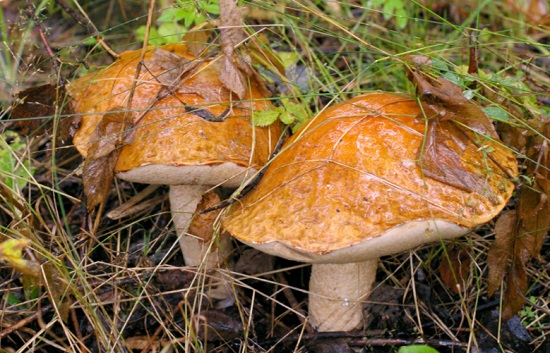
Butterflies grow in coniferous forests. They have an oily brown hat, which gave the name to the mushroom.
Flywheel can be found in a pine forest on sandy ground. It has a color from light green to yellowish-brown.
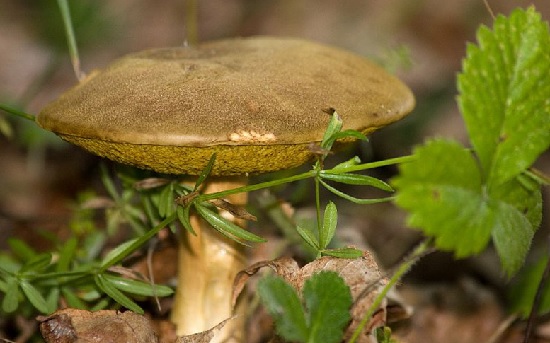
Poisonous and inedible mushrooms
Among tubular mushrooms there is a small number of poisonous and inedible representatives. Such mushrooms are unpleasant in smell and bitter in taste. They are not deadly poisonous, but cause gastrointestinal disorders and various poisonings.
In the list of poisonous tubular mushrooms there are such representatives: wolf boletus, pepper and gall mushrooms, satanic pain.
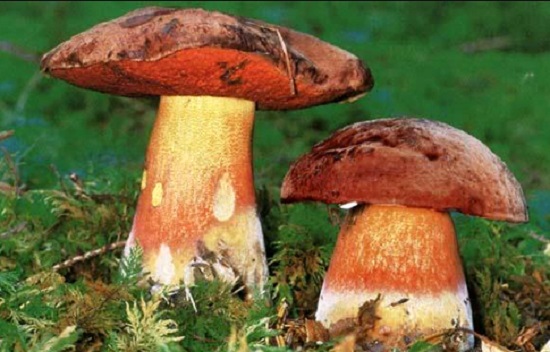
The only deadly poisonous tubular representative is the satanic mushroom. It has a resemblance to a boletus. You can distinguish it from the edible by breaking the hat. It immediately has a bright red color, which gradually darkens and turns blue. The spores of this fungus are also colored red.
When it enters the human body, it causes severe vomiting and disorder digestive system accompanied by diarrhea. In the worst case, defeat nervous system and respiratory systems.
Beginning mushroom pickers prefer tubular ones when picking, since there are few among them. poisonous mushrooms. In addition, poisonous species can be found quite rarely.
Related content:
Tubular mushrooms.
Porcini.
Many people call him a boletus. It is one of the largest and most valuable of all cap mushrooms. White mushrooms, especially young ones that are not damaged by rodents, slugs and insects, have not only an exceptional taste, but also a very attractive appearance. Their clean, ruddy hats look like freshly baked muffins.
White fungus grows throughout the Soviet Union from June to October, on moderately moist soil, rich in humus and well warmed by the sun, in birch, oak, pine, spruce and mixed forests, singly, but more often in groups. During the period of mass fruiting, from the second half of August and in September, it often appears in groups of 10-20 or more pieces.
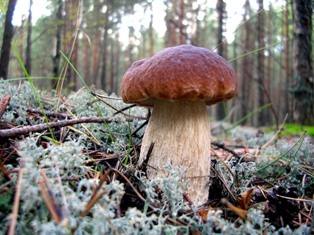 The size and shape of the cap depend primarily on the age of the fungus. In young people, it is hemispherical, with age it becomes convex and even flat, reaching a diameter of up to 25 cm or more. The color of the cap is very different - from almost white to dark brown with a purple tint. It depends on which forest the mushrooms are in. In mushrooms growing in a pine forest, it is dark brown, often with a purple tint, in a spruce forest it is brown or reddish-brown, in deciduous forests it is lighter. The tubular layer is finely porous, first white, then yellowish green. The leg is up to 15 cm long or more, its thickness is up to 8 cm, as a rule, at first tuberous, then almost cylindrical, whitish or light brownish, with a white mesh pattern. The flesh is white, dense, does not change color when broken, without much taste, but with a pleasant mushroom smell.
The size and shape of the cap depend primarily on the age of the fungus. In young people, it is hemispherical, with age it becomes convex and even flat, reaching a diameter of up to 25 cm or more. The color of the cap is very different - from almost white to dark brown with a purple tint. It depends on which forest the mushrooms are in. In mushrooms growing in a pine forest, it is dark brown, often with a purple tint, in a spruce forest it is brown or reddish-brown, in deciduous forests it is lighter. The tubular layer is finely porous, first white, then yellowish green. The leg is up to 15 cm long or more, its thickness is up to 8 cm, as a rule, at first tuberous, then almost cylindrical, whitish or light brownish, with a white mesh pattern. The flesh is white, dense, does not change color when broken, without much taste, but with a pleasant mushroom smell.
Suitable for processing in all forms.
Berezovik.
More often this mushroom is called boletus, and in some areas it is gray, gray, black. 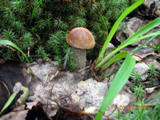
Mushroom, osovik, obabkom. Birch is widely distributed throughout Soviet Union, grows from the first half of June to October in birch and birch-mixed forests, even in birch bushes, on edges and clearings, on soils of various composition and moisture content, singly or in groups.
The hat is up to 12-15 cm in diameter, in young it is convex, then cushion-shaped, naked or thin-felt, dry, but wet in wet weather, sticky in old mushrooms. The color of the cap is white, gray, gray-brown, brown, black, sometimes spotted. The tubular layer of young mushrooms is white, later usually gray or brownish-gray. In old mushrooms, it is often uneven, slightly convex, with larger tubules. The stalk is long, thin in most varieties, slightly thickened downwards, solid, white, with white, gray, brown or black scales. The pulp is white at the break, as a rule, does not change color, in old mushrooms it is loose, watery. There are birch trees with a gray or spotted hat, in which the flesh turns pink at the break.
Depending on the place of growth, up to 12 varieties of birch trees differ from each other in the size of fruiting bodies, their color and even quality. On the territory of the center of Russia, such forms of this fungus are distinguished: ordinary grayish-brown, white small marsh, with a black hat and pinkish flesh, arctic with a small fruiting body and a light brownish hat, and others.
The most valuable is the common birch, which has a grayish-brown, almost black hat, a thick leg with black scales on it, and a grayish-white tubular layer. The flesh of this fungus does not change color when broken.
The lowest quality is white marsh birch, which grows in damp places, it is very watery, its flesh is weak, quickly deteriorates, crumples in the basket, so the mushroom is often almost unsuitable for harvesting for future use.
The mushroom is boiled, fried, pickled and dried. But when dried, this mushroom darkens.
Aspen.
This mushroom is more often called boletus, and in some areas red mushroom, red, 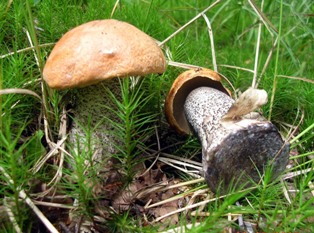
and young mushrooms - chalyshami. Aspen is a large and valuable mushroom. It grows from June to October throughout the USSR in deciduous and coniferous forests mixed with aspen on different soils, even in the tundra, singly, more often in groups.
The cap is up to 30 cm in diameter, fleshy, in young it is hemispherical, closely pressed to the stem with edges, then convex to cushion-shaped, slightly velvety, dry, sometimes with a skin hanging along the edge. The color of the cap is red, orange, rarely grayish or white. The tubular layer is initially white, then dirty whitish and even dirty gray-brown. Leg up to 20 cm long, up to 6 cm thick, thickened downwards, solid, white, with oblong white, brown or black scales. The pulp is strong, dense, white, at the break and when cut, it quickly turns blue, and then turns black.
Apparently because aspen grows not only in the vicinity of aspen, but also with other tree species, a number of its forms are distinguished: red, with a red and dark red cap, with fibrous white scales on a relatively even thin white stem, usually grows in aspen forests ; brownish-yellow, with black scales on the stem, grows in pine and birch forests; gray - in poplar forests; almost white - in wet pine forests, where, in addition to pine, spruce and other tree species grow. It should be noted that even in the same forest one can often find aspen with different hat colors. However, regardless of the color of the hat, their value is the same.
Aspen is boiled, fried, marinated. Some are salted and dried. When dried, it turns black, and the decoctions of soups and broths turn dark from it.
Late oiler.
In some localities and in the literature, this mushroom is called maslyuk, butterfish. It grows from June to October, usually in large groups, throughout the European part of the USSR and in Siberia, in pine forests, often young ones, on edges, glades, near forest roads and paths.
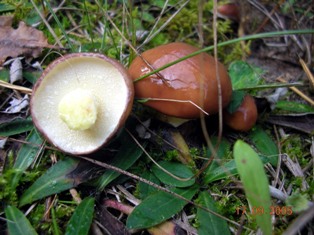
The cap is up to 10 cm in diameter, in young it is convex, then almost flat, with a tubercle in the middle, with an easily detachable mucous skin. The color of the cap is chocolate-brown with a purple tint, yellow or grayish-yellow. The tubular layer of pale yellow color is initially covered with a white film, easily separated from the pulp. Leg up to 8 cm long, up to 2 cm thick, cylindrical, solid, seated in the upper part with small warts, initially pale yellowish, later lemon yellow. In a young mushroom, the upper part of the stem is connected to the cap with a white film (veil), which breaks with the growth of the fungus, forming a ring on the stem. This ring is whitish at first, then darkens to faint purple. The flesh is whitish-yellow, does not change color at the break, with pleasant smell reminiscent of the smell of fruits. Butter dish is boiled, fried, marinated and salted. The goat, mossiness mushrooms are similar to the late oiler.
Flywheel green.
In some areas it is called a grate, a sublattice. It grows from June to October almost throughout the entire territory of the USSR, in coniferous, deciduous and mixed forests, singly and in small groups. The cap is up to 12 cm in diameter, convex in a young mushroom, then cushion-shaped, flatter in the center, thin-felt, often cracked. The color of the cap is olive-brown or yellowish-olive. The tubular layer is bright yellow, later greenish yellow, with large uneven angular pores. Leg up to 8 cm long, up to 2 cm thick, cylindrical, solid, yellow, sometimes with a reddish tinge. The pulp is weak, whitish or light yellowish.
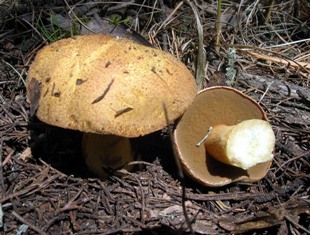 The green flywheel has several forms, depending on the color of the cap and the nature of the surface of the stem, but their quality is the same, and therefore these differences do not matter for use in food.
The green flywheel has several forms, depending on the color of the cap and the nature of the surface of the stem, but their quality is the same, and therefore these differences do not matter for use in food.
Green mushrooms are boiled, fried, young mushrooms are pickled and salted.
Flywheel yellow-brown. In some places it is called a swamp. In science, this mushroom is usually referred to as oil. It grows in July-October, mainly in the northern half of the forest zone of the European part of the USSR, in pine forests, more often on moist mossy soil, singly and in groups.
The cap is up to 10 cm in diameter, in young mushrooms it is convex, then almost flat, with thin edges, finely felted, later fibrous-scaly, slimy in wet weather, with a non-peeling skin. The color of the cap is ocher-yellow, brown or brownish. The tubular layer is first dull yellow, then yellow-olive. Leg up to 8 cm long, up to 2 cm thick, often cylindrical, solid, pale yellow, sometimes with a brownish tint. The flesh is odorless and tasteless, pale orange or yellowish, turning blue at the break and cut.
Mokhovik yellow-brown is boiled, fried and marinated. They rarely dry it.
Kozlyak.
In some areas it is called mullein, moss fly, grate. It grows from July to October, mainly in the northern half of the forest zone of the USSR, in pine forests, more often in moist forests and sphagnum bogs, where pine grows, singly and in small groups.
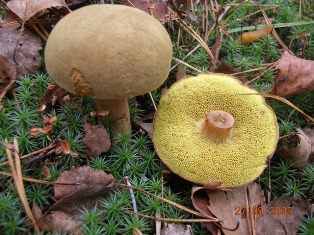
The cap is up to 10 cm in diameter, in young mushrooms it is convex, then flat, smooth, usually with a wavy and slightly curved edge, slimy in wet weather. The color of the cap is ocher-brown. Tubular layer with wide angular uneven pores, first grayish-yellow, later brownish-olive. Leg up to 8 cm long, up to 1.5 cm thick, cylindrical, solid, smooth, often bent, almost the same color as the hat or slightly lighter. The pulp is not brittle, yellowish, with a slight odor, slightly blue at the break. It has some external resemblance to an inedible pepper mushroom.
The goat is boiled, fried, marinated. Young fungi are suitable for salting and even drying.
About pickling mushrooms at home with a photo.
This family is rightfully considered one of the most collected by man after agaric mushrooms. In this family, there are many of the most popular representatives of the type of white fungus and its varieties. This determines the popularity of this group of tubular fungi. In addition, they can be collected from June to October.
tubular edible mushrooms
There is not much diversity here, since all mushrooms of this type are variations of the same class. These include porcini mushrooms (boletus mushrooms), boletus mushrooms, aspen mushrooms, late butterflies, green fly mushrooms, goats, etc. All of them are mushrooms that can be easily eaten, and not only by frying or cooking soup from them, but also by pickling or pickling for the winter.
Naturally, there are a great many recipes for preparing any type of these dishes. So, tubular edible mushrooms are one of the most popular in humans. But you should also be wary of their counterparts, which, unfortunately, exist no less than the real mushrooms themselves.
Poisonous tubular mushrooms
Until recently, for some reason, it was believed that all fungi of the tubular family are edible. As it turned out, this is not at all the case. The fact is that poisonous tubular mushrooms are rare, however, among their representatives there are many inedible, and sometimes frankly poisonous mushrooms. Suffice it to mention such species as the peppery butterdish and the Siberian butterdish, the parasitic flywheel and the gall fungus. In addition, there are several species whose edibility and suitability for cooking have not yet been fully determined. So, for example, among such representatives of tubular mushrooms, one can distinguish pink-golden boletus and false satanic mushroom. Even many experts cannot yet say for sure how edible such mushrooms are. But for an ordinary mushroom picker who is not knowledgeable in this area, as they say, it’s better not to take risks, because you can not only get the usual food poisoning, but also "play in the box." And this, of course, no one wishes for himself. So, before taking tubular mushrooms in the forest, it’s better to play it safe a hundred times and at least study the main features and differences between poisonous tubular mushrooms and real ones, which can be eaten without risking health. To do this, you can use knowledge in determining the distinguishing features, at least, according to appearance not to mention the smell or taste.






